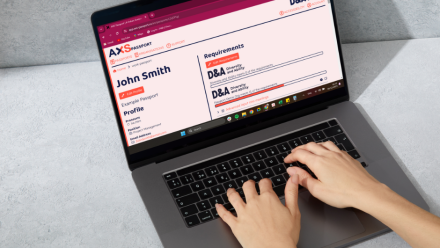The European Accessibility Act: Why it matters and how to stay ahead
24th January 2025 by Ellie Thompson
Accessibility shouldn’t be seen as a chore. It’s a golden ticket that opens your business up to new talent pools, new markets, and new ideas. The introduction of the European Accessibility Act heralds the start of a new era, where organisations won’t just have new responsibilities to include disabled people- they’ll get to reap the rewards of an accessible business.
The Act comes into effect in June 2025. Will your business be ready?
The European Accessibility Act: The basics
The European Accessibility Act establishes accessibility requirements for any business that wishes to trade in the European Union (EU). The aim is to improve the accessibility of products and services for disabled people across the EU.
Here’s what you need to know:
Who does the Act apply to?
It applies to all businesses that wish to trade in the EU. Yes, that means even if your business is based outside of the EU. It also applies to both public and private sector organisations. Your business will only be exempt if you have fewer than ten employees and a turnover of less than 2 million euros.
What does it cover?
It covers all types of products and services, although primarily focused on digital provisions, including:
- Websites, digital and E-commerce platforms
- Computers and smartphones
- TVs and media broadcasting products
- Transport services
- ATMs (cash machines), ticket machines and e-readers
- Telecommunications, including phone services and emergency communications (for example, calls to 999)
The accessibility requirements state that relevant products must be designed to “maximise their foreseeable use” by disabled people. This is what we at D&A have always advocated for: an anticipatory welcome where spaces, products and services are accessible from the start. Waiting until you’re asked to make adjustments doesn’t just create barriers for disabled people; it’s a costly drain on businesses’ time, money, and productivity. Customers like ours- such as Fujitsu– are already primed for the EAA. By working with us, your organisation can stay ahead- not just of this Act, but of future inclusion legislation, too.
Under the Act, “maximising foreseeable use” means ensuring that disabled people can access, perceive, operate, understand and control the product. In practice, this could mean:
- Using multiple sensory channels for information delivery: For example, websites, products or self-service terminals shouldn’t rely solely on visual (eg, colour) or auditory (eg, sound) cues to convey information.
- Ensuring compatibility with assistive technologies: Websites should work seamlessly with assistive technologies, such as allowing keyboard navigation for those who don’t use a mouse or trackpad, and ensuring screen reader accessibility by providing descriptive text (alt text) for images and other visual elements.
- Avoiding reliance on fine motor skills: Products mustn’t require dexterity or significant strength to operate.
When does it come into effect?
- It becomes law in all EU member states on 28th June, 2025. That means businesses will be required to comply with the act from this date onwards, ensuring that any new products meet legal accessibility standards.
- For existing products, businesses have until June 2030 to ensure products are compliant. After this date, the Act will apply to all products, both new and existing.
How is it enforced?
- Compliance and enforcement will be monitored and managed at the national level, by each individual EU member state. That means penalties may vary between member states, but could include fines and criminal sentences.
The impact
Although this is an EU Act, the impact will be global. Where private companies have previously been less accountable for accessibility measures, they will now have a legal responsibility to ensure disabled people can access their products if they want to trade within the EU or deliver services to an organisation that trades within the EU.
But, as long as you’re prepared, the Act offers an opportunity, not a burden.
Having accessible products and services means accessing broader and more diverse audiences. A quarter of the EU’s working-age population is disabled, so the question shouldn’t be can you afford to be accessible; it’s can you afford not to be?
What’s more, there are already legal consequences for having inaccessible products, services and spaces. For example, within the UK, public sector bodies are required to have accessible websites. And those with inaccessible products may be found liable under the Equality Act for discriminating against disabled people.
Complying with the EAA reduces the risk of facing legal action not just directly under the Act but also indirectly under other national and international rules and regulations.
How to be ready
The clock is ticking, so don’t wait until June to start improving your accessibility. By starting the process now, you can spread the cost, demonstrate your commitment to accessibility, and future-proof your organisation.
Here’s your action plan to get ahead of the game:
-
Assess yourself against the frameworks and standards.
Do your products fall under the scope of the Act? Where might you be falling short of accessibility requirements? What can you change now to guarantee your compliance in June? - Feel confident you’re not missing anything with accessibility audits
Review all of your digital content, from your website to your marketing materials.A digital accessibility audit makes this easy. You’ll get expert insight on accessibility dos and don’ts, lived experience user testing of your products, and a tangible action plan to make sure you’re ready for the Act’s introduction. -
Get your team on board
Don’t take it on alone! When your team understands and appreciates accessibility, new products will be inclusive from the start, guaranteeing EAA compliance and product success! Our accessibility audits include a virtual findings presentation, so your team and stakeholders will know the what, why, and how of any changes.
Accessibility is a growth strategy
Aligning with the European Accessibility Act requirements now means being one of the first to take the decisive step to building a more inclusive society. But it also presents a unique opportunity for businesses to innovate, expand their reach, and future-proof their operations.
Ready to take that step? Join our customers and get ahead of the act with our digital accessibility audits. You’ll easily navigate the requirements and create solutions that work for everyone.


